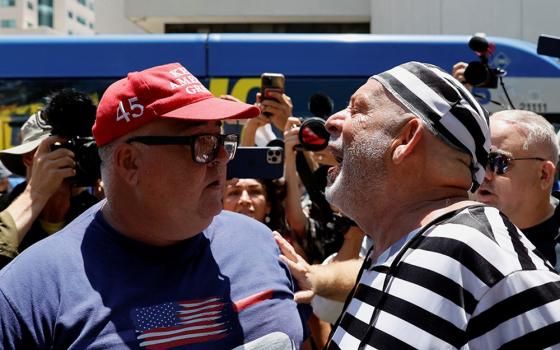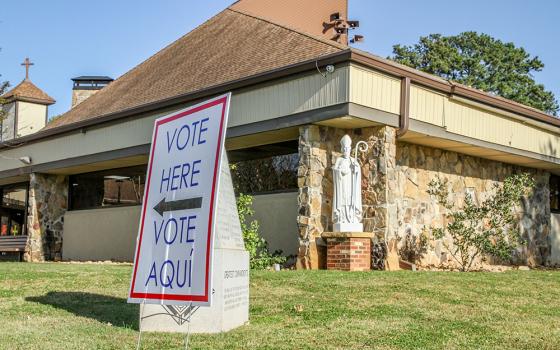
Light shines on a crucifix in the Metropolitan Cathedral in Mexico City. (CNS/Chico Sanchez)
Catholics from China admit feeling embarrassed when they see a crucifix. Beyond the image of a tortured man suffering execution, the crucifixion depicts total humiliation, or "loss of face" as the Chinese say. To them, this seems harsher than the physical pain.
The trouble with the crucifix is we no longer see it, but rather filter the image through our eyes of faith. Some people wear it as an accessory like gold earrings or a necklace; others use it as a talisman to ward off evil, if not vampires. A few brave souls even have it tattooed on various parts of their anatomy. The truth is, if we actually took the time to see the crucifix, we, like the Chinese, would be shocked, if not thoroughly scandalized.
While the Romans did not invent this particularly brutal form of capital punishment, they certainly perfected it. They were not interested in simply killing criminals; they intended to demean and dehumanize them. The slow, tortuous death was a bonus. The public spectacle served not only as a punishment for miscreants but also as a warning to anyone who harbored similar rebellious thoughts.
When I ask Bible study groups why Jesus was crucified, I get the formulaic "He died for our sins" or sometimes "He died to show God's love for us," which are true enough, but not complete. Certainly the powers-that-be who conspired to silence the pesky rabbi from Nazareth didn't have the salvation of the human race in mind. Rephrasing the question: "What did Jesus do to deserve crucifixion?" proves more thought-provoking. Clearly Jesus and his message posed a threat to the status quo, both religious and political. His cleansing of the Temple was the last straw. But the physical expulsion of merchants and moneychangers from the Court of the Gentiles was simply the final, dramatic manifestation of Jesus' scandalous message throughout his ministry: God loves everybody, unconditionally.
This subversive theology actually started with John the Baptist offering forgiveness free of charge on the banks of the Jordan. Who needs grain and doves and sheep to sacrifice if God only requires repentance to grant forgiveness? If people could encounter the power of God in the desert through a prophet, what purpose do priests and Temple serve? Jesus took this to the next level, not just forgiving but healing. Without fanfare, Mark's Gospel describes this seismic shift with almost a throwaway line, when Jesus touches a leper (Mark 1:41). The Law of Moses clearly states touching unclean people renders you ritually unclean as well, but here the opposite occurs: The love of God made visible in Christ makes the leper clean.
Time and again, Jesus put people above religious proscriptions: healing on the Sabbath, touching the bier of a dead child, talking to a Samaritan woman, dining with tax collectors and sinners, saving an adulteress, holding up a publican as more righteous than a Pharisee and a Samaritan as more virtuous than priests and Levis. We no longer feel the indignation pious Jews must surely have felt when Jesus declared a Roman soldier (read: foreign, pagan, oppressor) possessed greater faith "than all in Israel" (Matthew 8:10).
Jesus must have known such blatant disregard for social norms and religious sensitivities would provoke a harsh response from the authorities. But he continued anyway. He remained resolute and true to his mission: to show that God's love, forgiveness and mercy are available to all, Jew and Gentile, slave and free, women and men.
Paradoxically, God's love for all people was both the reason for and the result of Jesus' crucifixion. Christ becomes the cosmic outcast so all sinners, misfits and outsiders -- in other words, all of us -- might be included among God's people.
As Christians, we are obligated to mirror this scandalous love to others. To do this we must let our egos "be crucified with Christ" (Galatians 2:20), and willingly accept the consequences of violating arbitrary laws and customs that serve only to exclude and divide people into "us" and "them."
How ironic that Rome practiced crucifixion as a punishment but now, 2,000 years later, we have transformed the crucifix into the symbol of divine love, mercy and forgiveness. Each necklace, earring or tattoo of the Crucified can encourage us to love and forgive others despite the scandalous consequences.
[Maryknoll Fr. Joseph R. Veneroso is a former editor and publisher of Maryknoll magazine and Revista Maryknoll, which have won multiple awards from the Catholic Press Association, and is the author of several books, most recently Mirrors of Grace (Orbis), as well as a forthcoming novel, The Chimera, a mystery-thriller based on the Shroud of Turin.]


